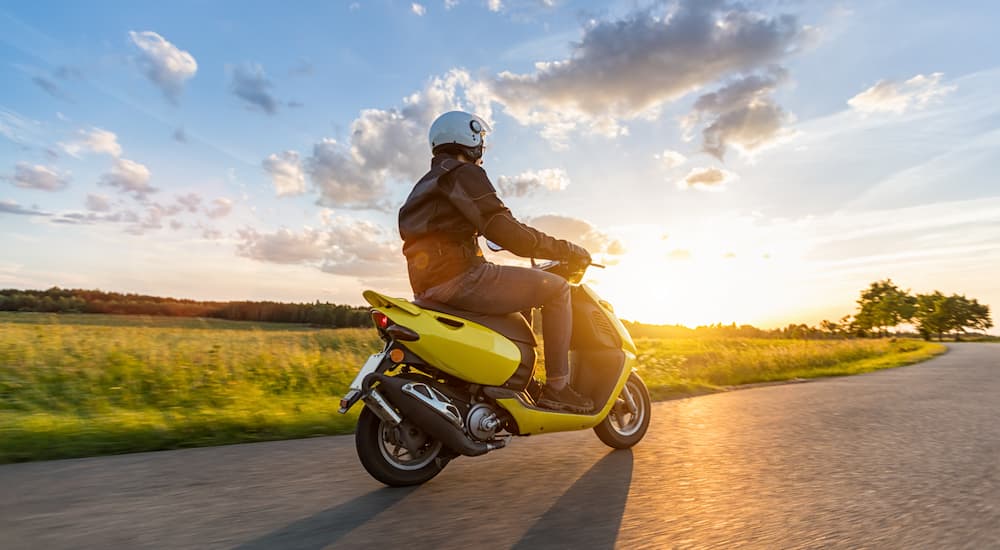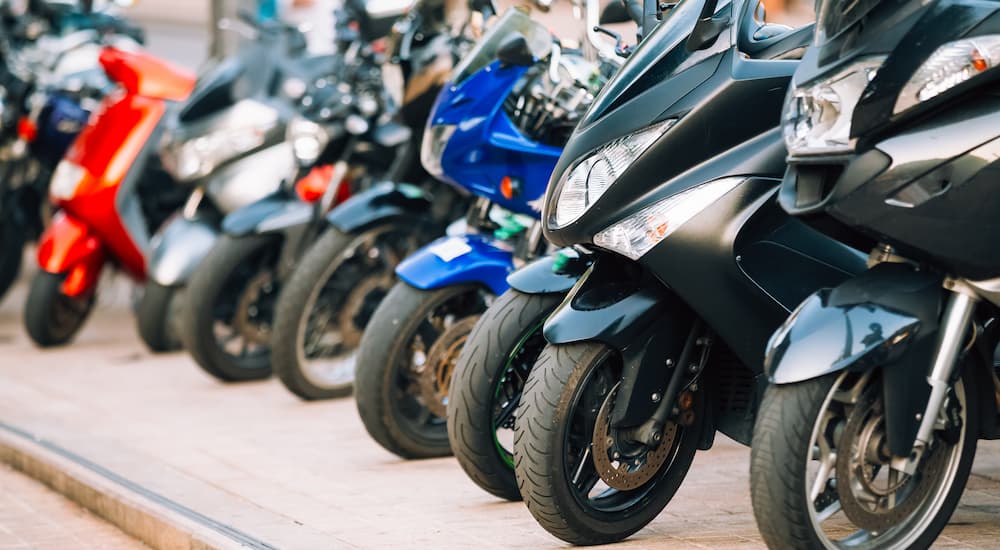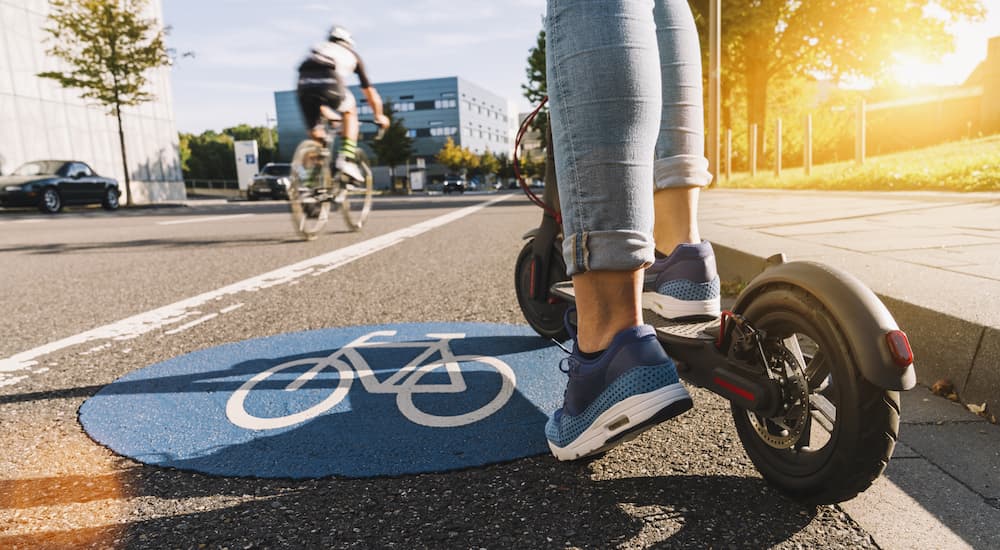Scooters might not be a practical choice for long-distance touring, but for those who live in a city and are looking to complete a few errands around town, they provide a convenient and fun alternative to public transportation, ride-sharing platforms, or walking. Scooters are easy to park and easy to weave through dense traffic, two factors that go a long way toward explaining their increasing popularity. While they might be more accessible than ever, those seeking scooters for sale have a few important decisions to make.
Following the model laid out by the now-ubiquitous Citi Bikes, a new generation of rentable electric scooters has taken many cities by storm. These “e-scooters” represent a real departure from the gas-powered models that have existed for almost 100 years. The differences between electric and gas-powered scooters are significant. Many e-scooters resemble an upsized version of a kid’s Razor scooter rather than the Vespa-like design of a traditional gas scooter. Each design has its advantages, but classifying them under the same “scooter” heading can lead to plenty of confusion.
With so many changes hitting the world of two-wheeled transportation, we thought it would be a good time to dive into some Scooter 101. From engine size and seating style to choosing between a gas and electric model, there’s a lot to consider when you’re in the market for a new scooter, so read on as we help you decide if a scooter is the right choice for your own transportation needs.
Moped vs Scooter
While some use the two terms interchangeably, there are actually some important distinctions to be made between scooters and mopeds. From engine size and top speed to legality and efficiency, let’s take a closer look at some of the key differences between these two-wheeled rides.
Moped
We’ll start with mopeds, which are the smaller of the two. Mopeds are usually built with smaller wheels than scooters, typically 10 inches or less. Mopeds typically have pedals like a bicycle, which you use to propel yourself forward as well as start the gas engine. The size of the engine is the real dividing line. Most mopeds feature a gas-powered engine that measures in at less than 50cc. This smaller powerplant limits a moped to a top speed of around 28 or 30 mph, a factor that severely limits where it can be used. Mopeds are generally barred from freeways and highways where their slower speeds can create a real safety hazard.
Mopeds are equipped with a twist-and-go automatic transmission, making them easy to operate without a whole lot of specialized knowledge. In most cases, a standard driver’s license is all you need to operate a moped, though some states do require special endorsements or licenses. They’re also more efficient than many scooters. A moped’s fuel economy might edge into the triple digits under certain riding conditions, making mopeds an easy and affordable way to get around town. Speaking of affordability, mopeds are often cheaper than scooters owing to their smaller engines.

Scooter
Generally speaking, a scooter is simply a larger moped without pedals. Again, definitions vary by jurisdiction, but as a general rule of thumb, any two-wheeled vehicle with an engine that measures larger than 50cc will be considered a scooter in the eyes of the law. Scooters range in size from 50cc up to 750cc for some “maxi-scooters” like the Honda Forza 750. Most models top out around 250cc. The larger engine means that a scooter can achieve much higher speeds than mopeds, with some models going as fast as 60 to 70 mph.
Higher speeds mean that scooters can go to many places that mopeds can’t, including the highway in some cases. For example, California classifies any scooter with an engine that’s 150cc or larger as a motorcycle and allows them on any of the state’s freeways. It might not be the most relaxed driving experience, but if you need to cut across town quickly and want to avoid some traffic lights, a short cruise on the highway isn’t out of the question, especially since splitting between lanes of stopped traffic is legal in California. While a moped might be able to get away with not displaying a license plate if it’s under 50cc and slower than 30mph, scooters are a different case altogether. In some states, drivers will need to obtain a specific motorcycle license, file for registration, and take out an insurance policy in order to operate a scooter. Like any motorcycle, a scooter must be equipped with headlights and turn signals.
Gas vs Electric
Once largely classified as toys and relegated to sleepy suburban streets, electric scooters are now a common sight in many cities. Scooter rental companies like Bird and Lime are looking to do for scooters what Citi Bikes did for short-term bike rentals, and are already making some significant headway. Bird now offers its e-scooters in over 400 cities across the globe, while Lime spans some 150 cities in more than 30 countries. These little scooters have become a big business over the last few years. According to one estimate, the electric scooter market is growing by some 13 percent a year with an expected valuation of $37 billion by 2028, and that’s just the electric side of the equation.
Gas-powered scooters have been on the market for decades and provide a larger, more powerful alternative to many of the electric models currently available. Traditional gas scooters might not be as nimble as some of the electric newcomers, but they are generally capable of higher speeds and, in some cases, can even be used for higher-speed travel. If you’re looking for a two-wheeled ride that can replicate the practicality of a traditional car, truck, or SUV for short-term transportation, a gas-powered scooter will certainly perform better than an e-scooter.
While they might share a name, many gas and electric scooters have little in common. Choosing between a gas and electric model is often one of the first factors a buyer must consider when in the market for a new scooter, so let’s take a quick look at some of the key differences between the two types.

Gas Scooters
Speed
If you feel the need for speed, a gas-powered scooter is probably the way to go. Capable of speeds of up to 70 mph, gas-powered scooters are often twice as fast as the speediest electric models. This increased speed allows gas-powered scooters to better keep up with traditional traffic, allowing riders to travel on higher-speed roads and even some highways without becoming an impediment.
Licensing
This increased speed does come with some downsides. As we’ll discuss later, any two-wheeled vehicle with a gas engine that’s 50cc or larger will face a lot more regulation than a model with a smaller displacement. From licensing to insurance and registration, a scooter that can hold its own on the highway will usually face the same regulation as a motorcycle, including the need for a special motorcycle endorsement on your driver’s license.
Range
One area where gas-powered scooters certainly have electric scooters beat is in the efficiency department. This might seem a little backward to those who would expect any electric vehicle to beat a gas-powered rival in terms of efficiency, but it all comes down to weight and engine size. An electric scooter relies on a battery to produce all its power, and even some of the industry’s most efficient power packs are limited to around 50 or 60 miles of range. A gas-powered scooter might only be able to hold two or three gallons of fuel in the tank, but the scooter’s low weight and ultra-efficient engine means that riders can travel as much as 100 miles on a single gallon. Boasting potentially six times the range of an electric scooter, it’s hard to beat a gas-powered scooter when it comes to pure mileage.
Comfort
Many gas-powered scooters are built with a more traditional design that includes a built-in seat, rather than one you must stand on to ride like many electric scooters. This can be a make-or-break factor for drivers who put a premium on comfort, as the seated position makes these scooters a more comfortable option for longer rides. Again, picture a traditional Vespa versus a Razor-like scooter you might find littering any suburban driveway. The seat position does mean these scooters are a little less maneuverable and heavier than smaller, lighter standing scooters, but it’s a pretty fair trade-off if you’re looking to improve the overall riding experience.

Electric Scooters
Safety
Electric scooters are worth a closer look if safety and sustainability are your chief concerns. The fact that electric scooters can’t match the speed of gas-powered models might be a dealbreaker for many riders, but it does bring certain advantages in overall safety. Simply put, the slower you travel, the less chance of a major accident. Gas-powered scooters also tend to run a little hot thanks to internal combustion, so there’s always the chance of burning yourself on the exhaust or engine itself. That won’t happen on an electric scooter.
Sustainability
Electric scooters might not have the same 100-mpg range as many gas-powered scooters, but they are a little easier on the environment thanks to their lack of emissions. E-scooters are also a significant improvement over gas-powered scooters when it comes to noise pollution, running virtually silent as compared to the buzzy, grating noise produced by the internal combustion process.
Licensing
In terms of licensing, most e-scooters face fewer regulations than gas-powered alternatives due to their slower speeds. Still, some of the more powerful models on the market might start to blur the line. With gas-powered scooters, this distinction is made based on engine size and top speed, but how do you draw a line when there’s no traditional engine to speak of? Sometimes, even police officers aren’t sure since the technology is so new, and the laws on the books may not have caught up with them yet. Many jurisdictions regulate e-scooters based on the wattage of their electric motors. An e-scooter with an electric motor that exceeds 1,500 watts might be classed along with motorcycles, while those under 1,500 watts might be treated more like other scooters. E-scooters with electric motors that fall below 750 watts face the fewest regulations, making them a great choice for riders who don’t want to cut through a bunch of red tape for that wind-in-their-hair feeling. In any event, it’s best to educate yourself on what laws apply to the specific e-scooter you want and how to comply with them where you live, and perhaps even carry a copy to show any law enforcement who might question you.
Scooting Into the Sunset
From size and expense to range and comfort, there are many factors to consider when jumping to two-wheeled transportation. Scooters might provide a convenient alternative to larger four-wheel vehicles, but they’re certainly not the right choice for every application. If you’re in the market for a gas or electric scooter, it’s important to be realistic about when, where, and under what conditions it’ll be used. Riders in more temperate regions might be able to get away with riding a scooter year-round, but these two-wheeled transports aren’t very useful when facing any sort of inclement weather or low temperatures.
Scooters can be a great addition to your garage, but they’re often not a realistic choice if you’re looking for a wholesale replacement for your existing car, truck, or SUV. That said, few vehicles can match the pure novelty of a scooter. Scooters are a great way to inject some fun into your everyday driving, from weaving through traffic and soaking up the sun to puttering around town or zipping to a nearby beach or park.



